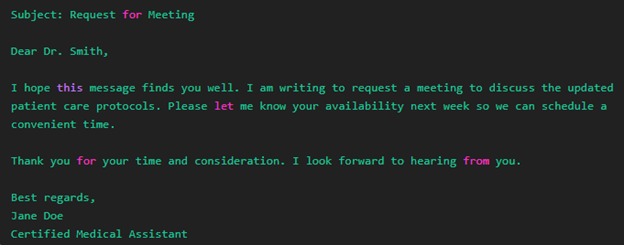5.6. Composing professional emails and correspondence
Learning Objectives
By the end of this lesson, students will be able to:
- Understand the importance of professional communication in healthcare settings.
- Identify the components of a professional email, including subject line, salutation, body, closing, and signature.
- Analyze sample professional emails for tone, structure, and clarity.
- Compose a professional email based on a given scenario, focusing on clarity, tone, and organization.
- Provide constructive peer feedback to improve email writing.
- Reflect on the role of effective written communication in their professional roles as CMAs.
Part 1: Warm-Up Discussion
Exploring Email Communication
Discuss the following questions as a group:
- Why is professional communication important in healthcare?
Your Answer: ____________________________________________ - Have you sent professional emails before? What challenges have you faced?
Your Answer: ____________________________________________ - Write down one key point from the discussion that stood out to you:
Key Point: ____________________________________________
Part 2: Introduction to Professional Email Structure
Components of a Professional Email
Review the key components of a professional email:
Subject Line: Clear and concise summary of the email’s purpose.
Salutation: Appropriate greeting (e.g., “Dear [Name],” or “Hello [Name],”).
Body: Organized message with an introduction, main points, and conclusion.
Closing: Polite closing remarks (e.g., “Best regards,” or “Sincerely,”).
Signature: Include sender’s name, position, and contact information.
Analyze the example email below and label each component:
Example Email:

| Email Component | Example Text |
|---|---|
| Subject Line | |
| Salutation | |
| Body | |
| Closing | |
| Signature |
Part 3: Analyzing Sample Emails
Email Analysis
In small groups, review the sample email provided by your instructor. Use the worksheet below to analyze the email:
Email Analysis Worksheet:
| Question | Your Answer |
|---|---|
| Is the subject line clear and concise? | |
| Is the tone professional and appropriate? | |
| Are the main points easy to understand? | |
| Are any components of the email missing or incomplete? |
After 10 minutes, share your group’s findings with the class.
Part 4: Writing Activity
Writing a Professional Email
Choose one of the following scenarios and write a professional email:
Scenario 1: Request a meeting with a physician to discuss patient concerns.
Scenario 2: Follow up on a patient’s test results.
Scenario 3: Address a scheduling conflict with a supervisor.
Use the template below to draft your email:
Email Writing Template:
| Email Component | Your Email Content |
|---|---|
| Subject Line | |
| Salutation | |
| Body | |
| Closing | |
| Signature |
Focus on clarity, tone, a
Part 5: Peer Review and Feedback
Reviewing Emails
Exchange your email with a partner and review it using the checklist below:
Peer Review Checklist:
| Criteria | Yes/No | Comments |
|---|---|---|
| Is the subject line clear and concise? | ||
| Is the tone professional and appropriate? | ||
| Is the email well-organized (introduction, main points, conclusion)? | ||
| Are there any grammar or spelling errors? | ||
| Is the email concise and to the point? |
Provide constructive feedback to your partner. After reviewing, revise your email based on their suggestions.
Part 6: Wrap-Up and Reflection
Reflecting on Email Communication
Reflect on what you learned in today’s lesson and answer the following questions:
- What is one thing you learned about professional email writing?
- How will you apply professional email skills in your future role as a CMA?
- Share your reflection with the class.
Media Attributions
- Example email © Chat GPT is licensed under a CC BY (Attribution) license

